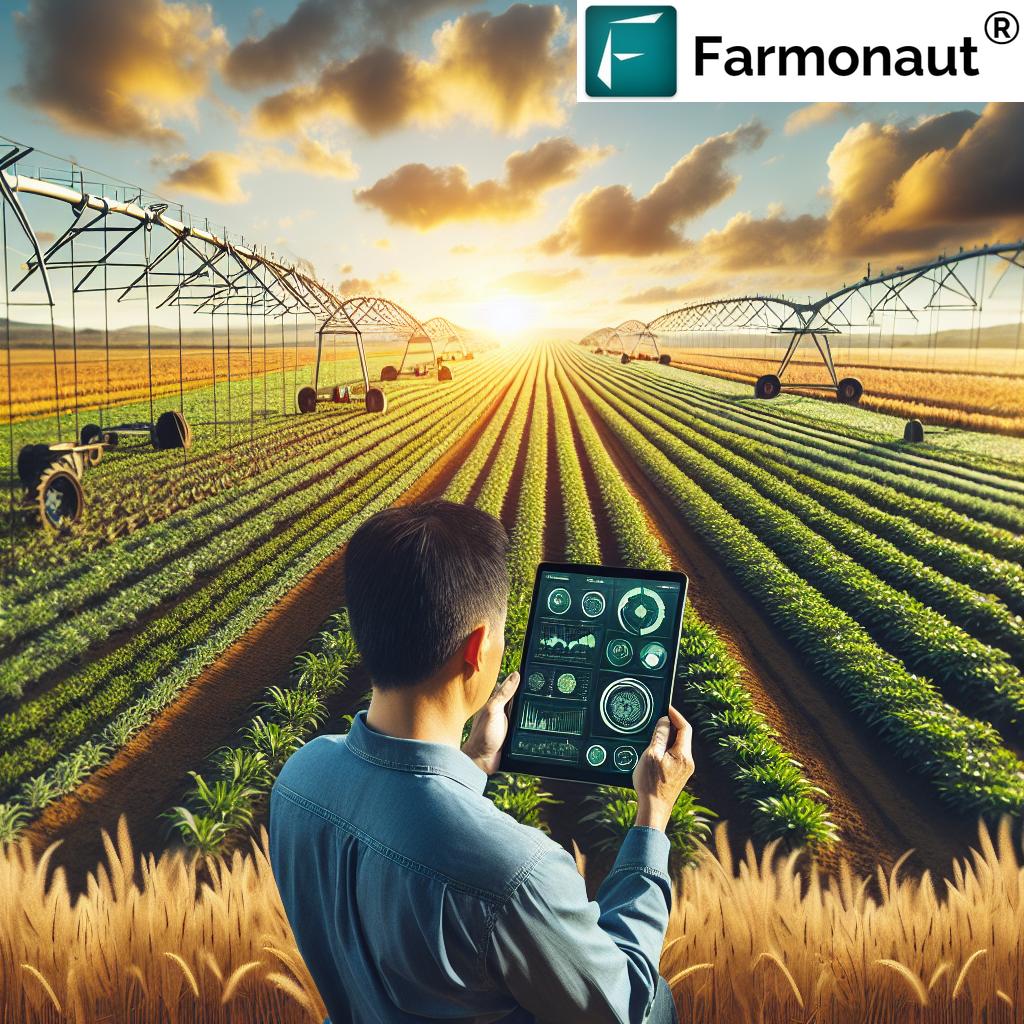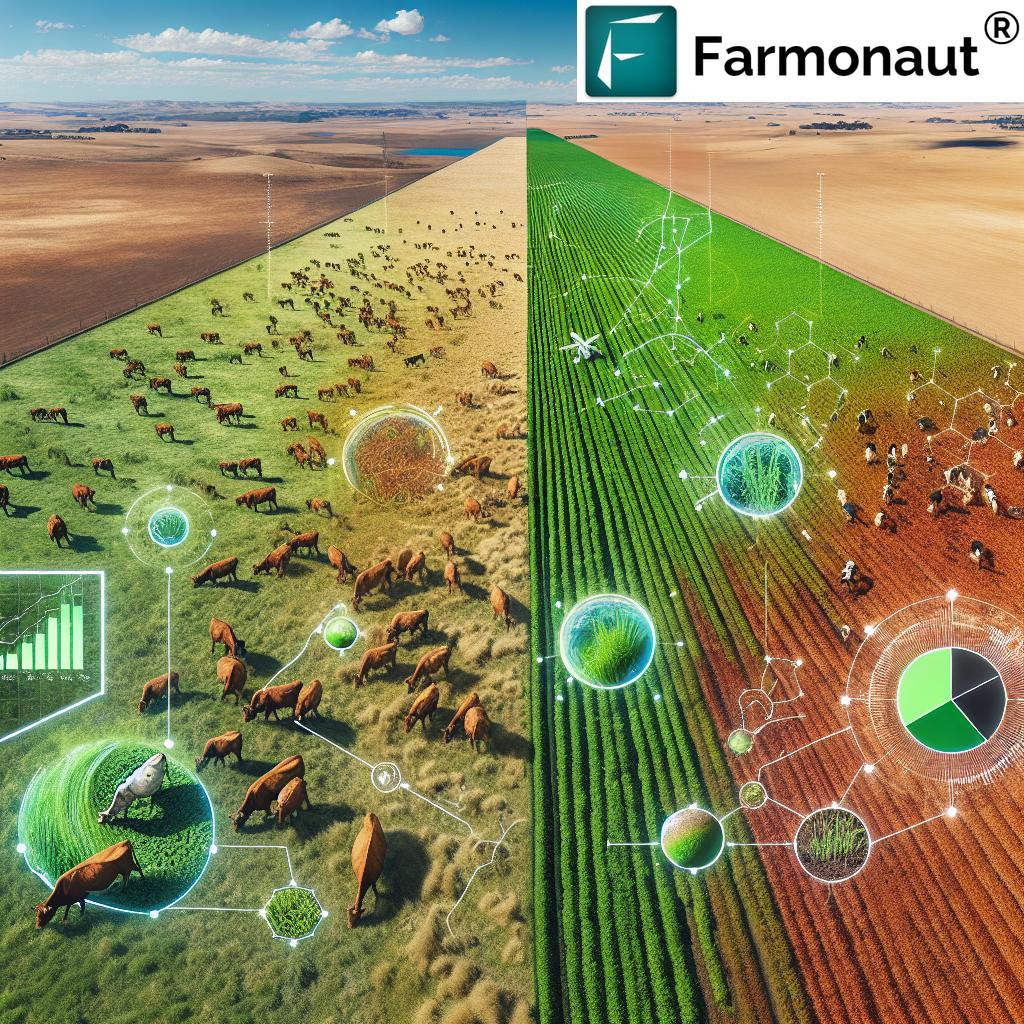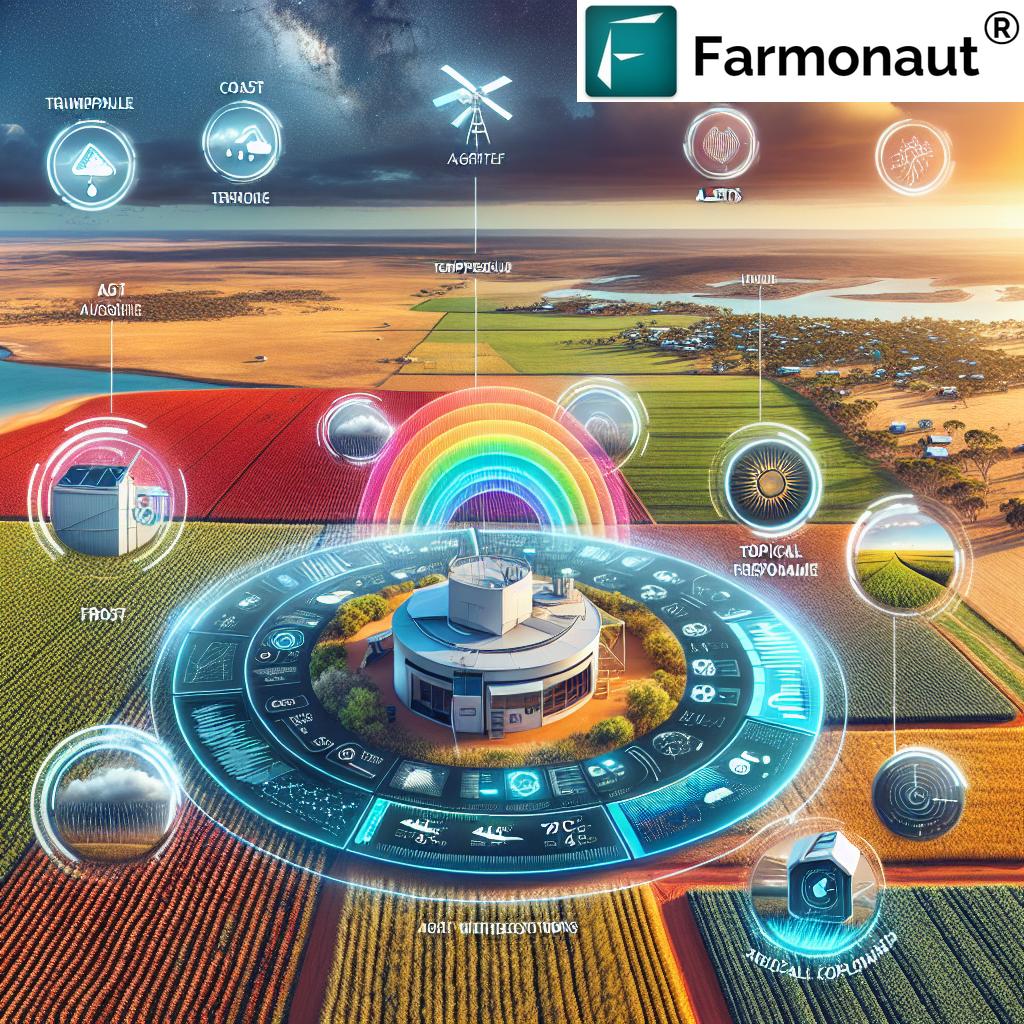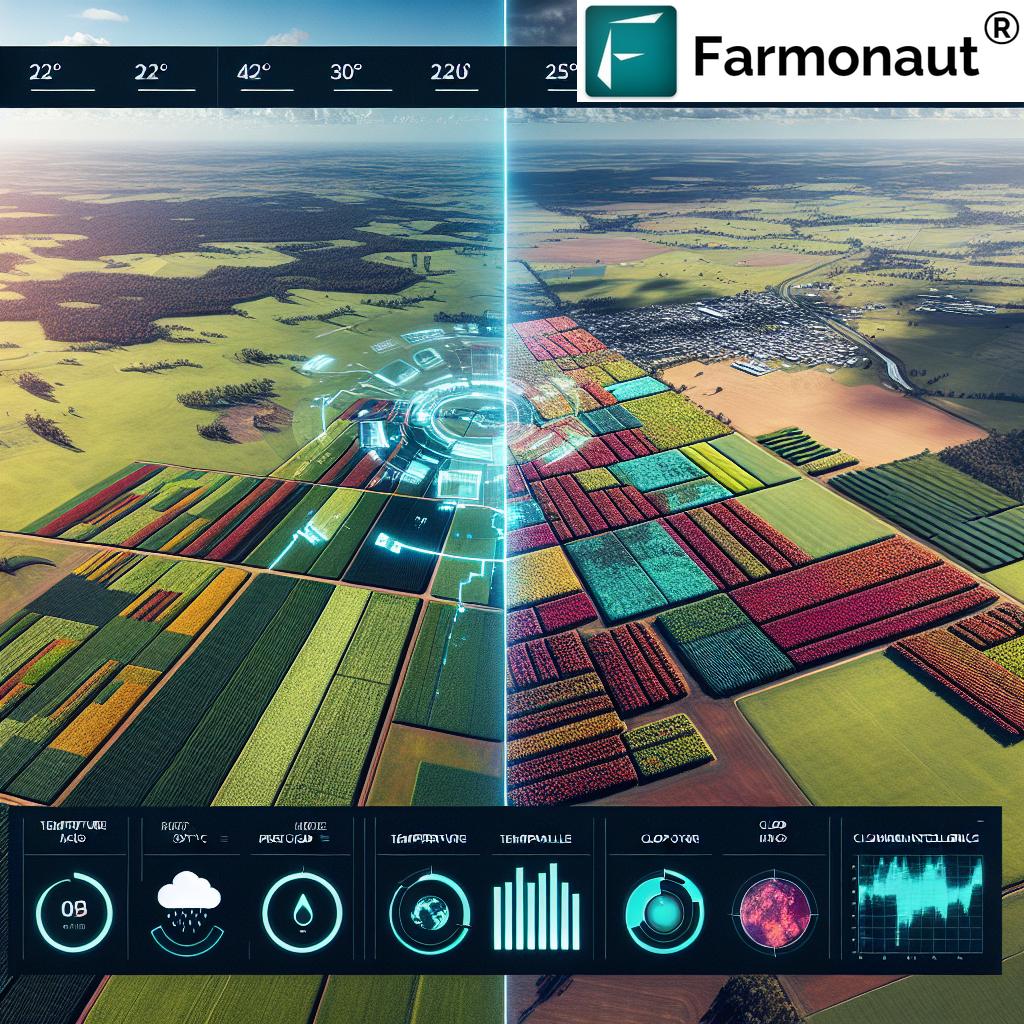Revolutionizing Australian Agriculture: Digital Innovations in Precision Farming and Sustainable Practices
“Australian farmers using precision agriculture techniques can reduce water usage by up to 30% compared to traditional methods.”
In the vast expanses of Australia’s agricultural landscape, a digital revolution is taking root, transforming the way we approach farming and food production. As we delve into the world of sustainable agriculture practices and precision farming technology, we’re witnessing a seismic shift in how Australian farmers manage their land, resources, and crops. This comprehensive exploration will take us through the cutting-edge digital agriculture solutions that are reshaping the industry, from innovative farm machinery to advanced crop yield optimization techniques.
At Farmonaut, we’re at the forefront of this agricultural transformation, offering satellite-based farm management solutions that make precision agriculture accessible and affordable. Our mission aligns perfectly with the evolving needs of Australian farmers, as we integrate innovative technology and data-driven insights into traditional farming practices.

The Digital Agriculture Revolution in Australia
The Australian agricultural sector is embracing digital innovations at an unprecedented rate. From the sprawling wheat fields of Western Australia to the lush pastures of Victoria, farmers are leveraging technology to boost productivity, enhance sustainability, and navigate the challenges posed by climate change. Let’s explore the key areas where digital solutions are making a significant impact:
- Precision Farming Technology: Satellite imagery, GPS guidance, and IoT sensors are enabling farmers to manage their fields with pinpoint accuracy.
- Crop Yield Optimization: Advanced analytics and AI are helping predict and improve crop yields, reducing waste and increasing profitability.
- Sustainable Water Management: Smart irrigation systems and water monitoring tools are revolutionizing how farms conserve and utilize water resources.
- Livestock Management Software: Digital solutions are streamlining the monitoring and care of cattle and sheep across Australia’s vast rangelands.
As we explore these innovations, it’s crucial to understand how they’re reshaping the agricultural landscape and contributing to a more sustainable and productive future for Australian farming.
Precision Farming: The Cornerstone of Modern Agriculture
Precision farming is at the heart of Australia’s agricultural revolution. By leveraging satellite technology, IoT devices, and data analytics, farmers can now make informed decisions about every aspect of their operations. Here’s how precision farming is transforming Australian agriculture:
- Satellite-Based Crop Monitoring: Platforms like Farmonaut use multispectral satellite imagery to provide real-time insights into crop health, soil moisture levels, and vegetation indices.
- Variable Rate Technology (VRT): Enables precise application of inputs like fertilizers and pesticides, reducing waste and environmental impact.
- GPS-Guided Machinery: Ensures accurate planting, spraying, and harvesting, minimizing overlap and maximizing efficiency.
These technologies are not just improving efficiency; they’re also contributing to more sustainable farming practices by optimizing resource use and reducing environmental impact.
Crop Yield Optimization: Harnessing Data for Better Harvests
Maximizing crop yields while maintaining sustainability is a key focus for Australian farmers. Advanced crop yield optimization techniques are making this goal more achievable than ever:
- Predictive Analytics: AI-driven models analyze historical data, weather patterns, and soil conditions to forecast crop yields and suggest optimal planting strategies.
- Precision Seeding: Advanced seeding equipment uses data to optimize seed placement and density, improving germination rates and overall yield.
- Crop Health Monitoring: Regular satellite imagery analysis helps detect issues like pest infestations or nutrient deficiencies early, allowing for timely interventions.
These techniques are not only boosting productivity but also helping farmers adapt to changing climate conditions and market demands.
Water Management: Tackling Australia’s Greatest Agricultural Challenge
In a country where water scarcity is a constant concern, innovative water management strategies are crucial. Digital solutions are playing a vital role in optimizing water use across Australian farms:
- Smart Irrigation Systems: Automated systems use real-time data on soil moisture, weather forecasts, and crop water requirements to optimize irrigation schedules.
- Soil Moisture Sensors: Networks of sensors provide detailed insights into soil moisture levels, enabling precise and efficient water application.
- Water Use Efficiency Tracking: Digital tools help farmers monitor and improve their water use efficiency, crucial for both sustainability and compliance with water regulations.
By implementing these technologies, Australian farmers are not only conserving water but also improving crop quality and yield consistency.
“Advanced crop yield optimization techniques in Australia have increased grain production efficiency by 15% in the last decade.”
Nitrogen Efficiency: Balancing Productivity and Environmental Stewardship
Nitrogen management is a critical aspect of sustainable agriculture. Australian farmers are adopting innovative methods to optimize nitrogen use:
- Variable Rate Fertilization: Using soil maps and crop health data to apply nitrogen precisely where it’s needed, reducing waste and environmental impact.
- Nitrogen Sensors: Real-time monitoring of crop nitrogen status allows for more accurate and timely fertilizer applications.
- Crop Rotation Planning: Digital tools help plan optimal crop rotations to naturally improve soil nitrogen levels and reduce reliance on synthetic fertilizers.
These methods not only improve crop yields but also contribute to the reduction of greenhouse gas emissions associated with excess nitrogen use.
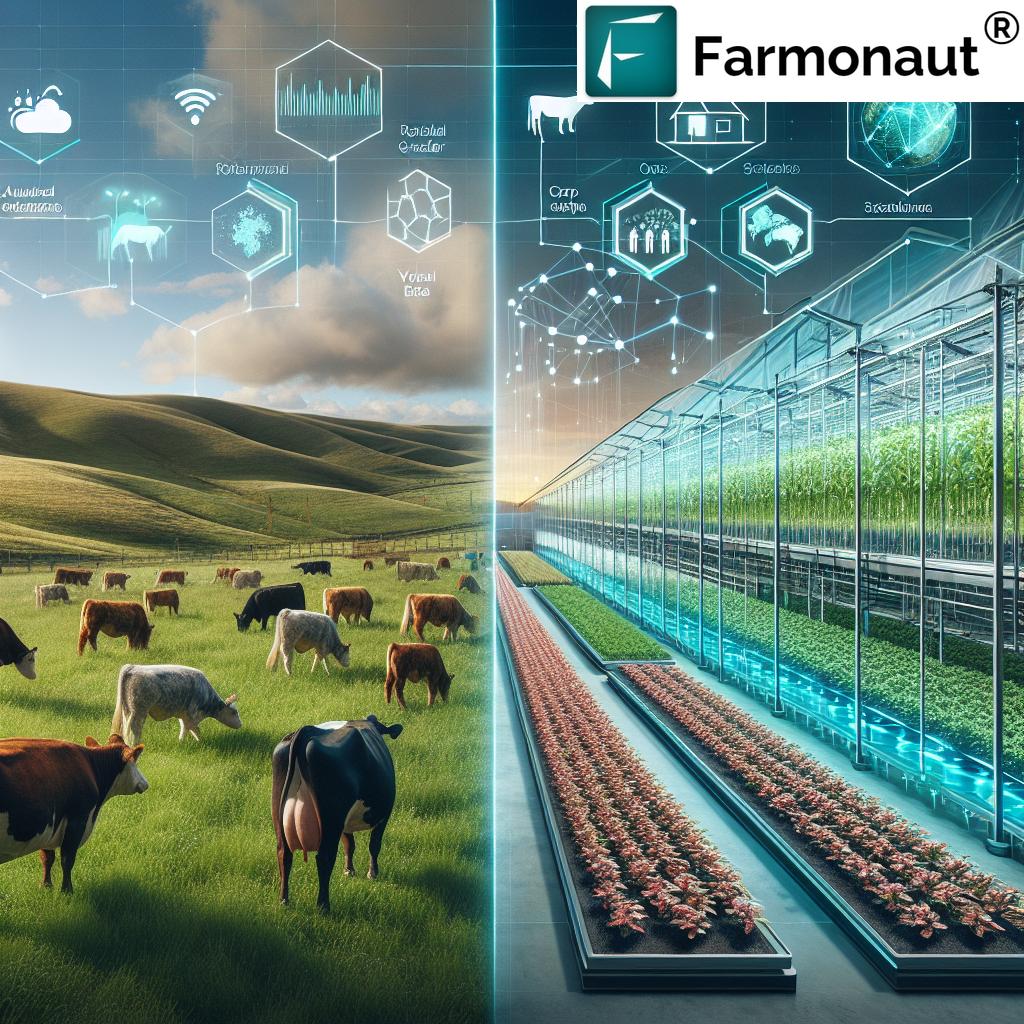
Livestock Management: Digital Solutions for Australia’s Pastoral Industry
Australia’s vast rangelands are home to millions of cattle and sheep. Digital innovations are transforming how these animals are managed:
- Livestock Management Software: Integrated systems for tracking animal health, breeding cycles, and production metrics.
- GPS Tracking Collars: Enable real-time monitoring of herd locations and movements, especially useful in extensive grazing systems.
- Automated Feeding Systems: Smart feeders adjust rations based on individual animal needs, improving feed efficiency and animal health.
These technologies are not only improving animal welfare but also increasing the efficiency and profitability of livestock operations.
Grain Storage Systems: Preserving Quality and Reducing Losses
Efficient grain storage is crucial for maintaining crop quality and reducing post-harvest losses. Australian farmers are adopting advanced storage solutions:
- Smart Storage Bins: Equipped with sensors to monitor temperature, humidity, and CO2 levels, ensuring optimal storage conditions.
- Automated Aeration Systems: Maintain grain quality by controlling moisture levels and preventing hot spots.
- Inventory Management Software: Digital tools for tracking grain quality, quantity, and market prices to optimize storage and sales decisions.
These innovations are helping farmers maximize the value of their harvests and reduce waste in the supply chain.
Broadacre Farming Innovations: Scaling Up Efficiency
Broadacre farming, a significant part of Australian agriculture, is benefiting greatly from digital innovations:
- Autonomous Machinery: Self-driving tractors and harvesters are increasing operational efficiency and reducing labor costs.
- Drone Technology: Used for crop scouting, mapping, and even targeted spraying, drones are becoming indispensable tools in broadacre farming.
- Integrated Farm Management Systems: Comprehensive platforms that combine data from various sources to provide a holistic view of farm operations.
These technologies are enabling broadacre farmers to manage large areas more effectively, improving both productivity and sustainability.
The Role of Biostimulants in Boosting Yield Potential
Recent research in Australia has shown promising results in the use of biostimulants to enhance crop yield potential:
- Seaweed Extracts: Rich in plant growth hormones and nutrients, these natural biostimulants can improve crop resilience and yield.
- Microbial Inoculants: Beneficial bacteria and fungi that enhance nutrient uptake and plant health.
- Humic and Fulvic Acids: Organic compounds that improve soil structure and nutrient availability.
The integration of biostimulants with precision farming techniques is opening new avenues for sustainable yield enhancement.
Harvest Preparation and Equipment Efficiency
Digital tools are revolutionizing harvest planning and equipment management:
- Harvest Timing Optimization: AI-powered systems analyze crop maturity and weather forecasts to determine the optimal harvest window.
- Equipment Maintenance Scheduling: Predictive maintenance software helps prevent breakdowns during critical harvest periods.
- Yield Mapping: Real-time yield data collection during harvest provides valuable insights for future crop planning.
These innovations are helping Australian farmers maximize their harvest efficiency and reduce post-harvest losses.
Policy Changes and Their Impact on Australian Farmers
The Australian agricultural sector is also being shaped by evolving policies and regulations:
- Sustainability Incentives: Government programs encouraging the adoption of sustainable farming practices through financial incentives.
- Carbon Farming Initiatives: Policies promoting carbon sequestration in agricultural soils, creating new income streams for farmers.
- Water Use Regulations: Stricter water allocation policies driving the adoption of water-efficient technologies.
Staying informed about these policy changes is crucial for farmers to remain compliant and capitalize on new opportunities.
The Future of Agriculture: Emerging Technologies and Trends
As we look to the future, several emerging technologies are poised to further transform Australian agriculture:
- Blockchain for Supply Chain Transparency: Enhancing traceability and consumer trust in agricultural products.
- Gene Editing Technologies: Developing more resilient and productive crop varieties adapted to Australian conditions.
- Vertical Farming: Urban agriculture solutions that could complement traditional farming methods.
These technologies promise to address challenges related to climate change, food security, and sustainable resource management.
Farmonaut’s Role in Australia’s Agricultural Future
At Farmonaut, we’re committed to supporting Australian farmers in their journey towards more efficient and sustainable agriculture. Our satellite-based farm management solutions provide valuable insights for decision-making:
- Real-time Crop Health Monitoring: Our satellite imagery analysis helps farmers detect issues early and optimize crop management.
- AI-based Advisory Systems: Personalized recommendations based on farm-specific data and regional trends.
- Resource Management Tools: Solutions for optimizing water use, fertilizer application, and other critical resources.
We invite Australian farmers to explore how Farmonaut can help them embrace the digital agriculture revolution:
For developers interested in integrating our technology into their own solutions, we offer comprehensive API access:
Digital Agriculture Innovations in Australia
| Innovation Category | Technology/Practice | Benefits | Adoption Rate (%) |
|---|---|---|---|
| Precision Farming | Satellite Imagery Analysis | Real-time crop health monitoring, optimized resource use | 45 |
| Water Management | Smart Irrigation Systems | Water conservation, improved crop quality | 35 |
| Nitrogen Efficiency | Variable Rate Fertilization | Reduced environmental impact, cost savings | 30 |
| Livestock Management | GPS Tracking Collars | Improved herd management, reduced labor costs | 25 |
| Grain Storage | Smart Storage Bins | Maintained grain quality, reduced losses | 40 |
| Broadacre Farming | Autonomous Machinery | Increased operational efficiency, labor savings | 20 |
Conclusion: Embracing the Digital Future of Australian Agriculture
The digital revolution in Australian agriculture is not just about adopting new technologies; it’s about reimagining farming for a sustainable and productive future. From precision farming techniques that optimize resource use to innovative livestock management solutions, the landscape of Australian agriculture is evolving rapidly.
As we’ve explored in this comprehensive overview, digital innovations are touching every aspect of farming operations. They’re helping farmers make more informed decisions, reduce their environmental impact, and increase their productivity. The integration of satellite technology, AI, and data analytics is opening up new possibilities for efficient and sustainable farming practices.
At Farmonaut, we’re proud to be part of this transformation, offering accessible and affordable precision agriculture solutions to farmers across Australia. Our satellite-based farm management tools are designed to empower farmers with the insights they need to thrive in this new era of digital agriculture.
As we look to the future, it’s clear that the continued adoption of digital technologies will be crucial for addressing the challenges facing Australian agriculture, from climate change to resource scarcity. By embracing these innovations, Australian farmers are not only securing their own futures but also contributing to a more sustainable and food-secure world.
We invite Australian farmers, agribusinesses, and agricultural stakeholders to join us in this digital revolution. Together, we can build a more resilient, efficient, and sustainable agricultural sector for Australia.
FAQs
- How is precision farming technology improving Australian agriculture?
Precision farming technology uses satellite imagery, GPS guidance, and IoT sensors to enable accurate field management, reducing resource waste and improving crop yields. - What are the benefits of using livestock management software?
Livestock management software helps track animal health, breeding cycles, and production metrics, improving overall herd management and profitability. - How are digital solutions addressing water scarcity in Australian farming?
Smart irrigation systems and water monitoring tools help farmers optimize water use, reducing consumption while maintaining or improving crop yields. - What role does AI play in crop yield optimization?
AI-driven models analyze various data points to predict crop yields, suggest optimal planting strategies, and help detect issues early for timely interventions. - How is blockchain technology being used in Australian agriculture?
Blockchain is enhancing supply chain transparency, enabling traceability of agricultural products from farm to consumer, which builds trust and reduces fraud.






